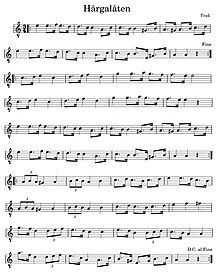Hårgalåten
Swedish folk song
You can help expand this article with text translated from the corresponding article in Swedish. (July 2022) Click [show] for important translation instructions.
- Machine translation, like DeepL or Google Translate, is a useful starting point for translations, but translators must revise errors as necessary and confirm that the translation is accurate, rather than simply copy-pasting machine-translated text into the English Wikipedia.
- Do not translate text that appears unreliable or low-quality. If possible, verify the text with references provided in the foreign-language article.
- You must provide copyright attribution in the edit summary accompanying your translation by providing an interlanguage link to the source of your translation. A model attribution edit summary is
Content in this edit is translated from the existing Swedish Wikipedia article at [[:sv:Hårgadansen]]; see its history for attribution. - You may also add the template
{{Translated|sv|Hårgadansen}}to the talk page. - For more guidance, see Wikipedia:Translation.

"Hårgalåten", or the "Harga song", is a Swedish folk song. The song is connected to a 1785 story published by Johan Gabriel Lindstrom.[1] The song describes how a mysterious fiddler came to the community near Hårgaberget [sv] or "Harga mountain", and played the fiddle. The youth danced to the tune that the fiddler played and they were unable to stop. Some of the youth noticed a cloven hoof, leading them to believe the fiddler was demonic. Even as morning came, the adults noticed they were all still dancing, and the fiddler still fiddling. Later, the dancers started dropping dead from exhaustion.[2]
References
External links
- Merrigan - Hårgalåten (Folk music) on YouTube
- Ofdrykkja - Hårgalåten (Official Music Video) on YouTube
- v
- t
- e










